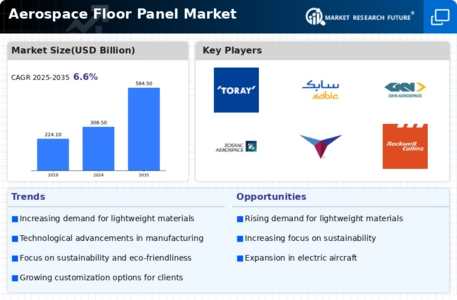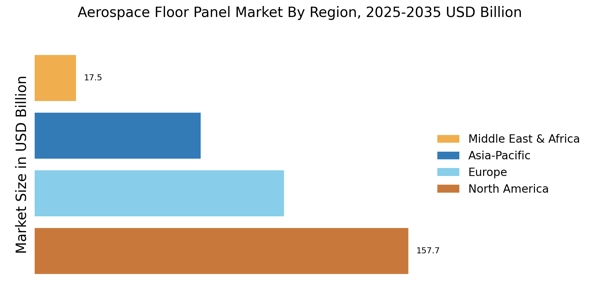Increased Demand for Lightweight Materials
The Aerospace Floor Panel Market is experiencing a notable shift towards lightweight materials, driven by the need for fuel efficiency and reduced operational costs. Manufacturers are increasingly adopting advanced composites and aluminum alloys, which offer significant weight savings compared to traditional materials. This trend is underscored by the fact that reducing aircraft weight can lead to a decrease in fuel consumption by approximately 5 to 10%. As airlines and manufacturers prioritize sustainability and cost-effectiveness, the demand for lightweight aerospace floor panels is expected to rise, thereby propelling the market forward.
Regulatory Compliance and Safety Standards
The Aerospace Floor Panel Market is significantly influenced by stringent regulatory compliance and safety standards imposed by aviation authorities. These regulations necessitate the use of high-quality materials and designs that ensure passenger safety and structural integrity. For instance, the Federal Aviation Administration (FAA) and the European Union Aviation Safety Agency (EASA) have established guidelines that manufacturers must adhere to, which often leads to increased investments in research and development. As a result, companies that prioritize compliance are likely to gain a competitive edge, thereby driving growth in the aerospace floor panel market.
Growth in Aircraft Production and Deliveries
The Aerospace Floor Panel Market is poised for growth due to the increasing production and delivery of commercial and military aircraft. According to industry forecasts, the demand for new aircraft is projected to rise significantly, with estimates suggesting that over 40,000 new commercial aircraft will be delivered in the next two decades. This surge in aircraft production directly correlates with the need for high-quality aerospace floor panels, as manufacturers seek to equip new models with advanced flooring solutions. Consequently, this growth trajectory is expected to bolster the aerospace floor panel market.
Rising Focus on Passenger Comfort and Experience
The Aerospace Floor Panel Market is increasingly influenced by the rising focus on passenger comfort and overall experience. Airlines are investing in cabin upgrades to enhance passenger satisfaction, which includes the installation of high-quality floor panels that contribute to a more pleasant environment. Features such as noise reduction, thermal insulation, and aesthetic appeal are becoming essential considerations in the design of aerospace floor panels. As airlines strive to differentiate themselves in a competitive market, the demand for innovative and comfortable flooring solutions is expected to rise, further propelling the aerospace floor panel market.
Technological Innovations in Manufacturing Processes
The Aerospace Floor Panel Market is benefiting from technological innovations that enhance manufacturing processes. Advancements such as additive manufacturing and automated production techniques are enabling manufacturers to produce aerospace floor panels with greater precision and efficiency. These technologies not only reduce production costs but also allow for the creation of complex designs that were previously unattainable. As manufacturers adopt these innovative processes, the overall quality and performance of aerospace floor panels are likely to improve, thereby attracting more customers and driving market growth.


















Leave a Comment